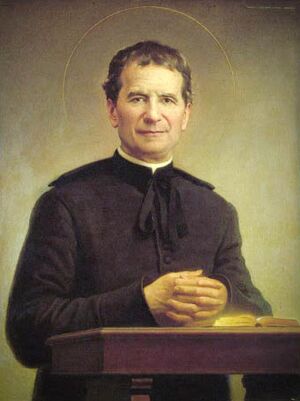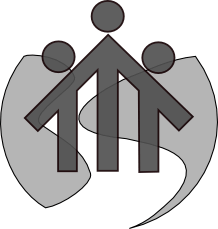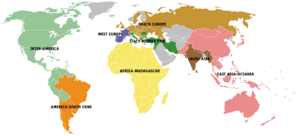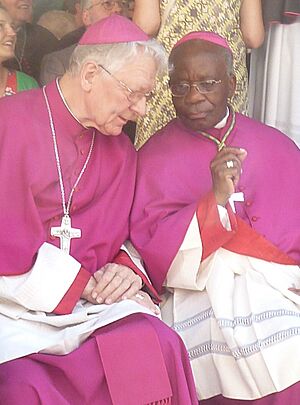Salesians of Don Bosco facts for kids
|
Societas Sancti Francisci Salesii
|
|
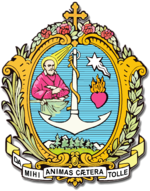
Coat of arms
|
|
| Abbreviation | SDB |
|---|---|
| Nickname | Salesians of Don Bosco |
| Formation | December 18, 1859 |
| Founder | John Bosco |
| Founded at | Valdocco, Turin |
| Type | Clerical Religious Congregation of Pontifical Right |
| Headquarters | Sacro Cuore di Gesù a Castro Pretorio Rome, Italy |
|
Membership (2022)
|
14,614 (128 bishops, 14,056 priests and 430 novices) |
|
Rector Major of the Salesians
|
Fabio Attard |
|
Vicar of the Rector Major
|
Stefano Martoglio |
The Salesians of Don Bosco (SDB) are a group of Catholic men. They are also known as the Society of Saint Francis de Sales. An Italian priest named John Bosco started this group in 1859. He wanted to help young people who were poor or moving to new places during the Industrial Revolution. The group is named after Francis de Sales, a bishop from the 1600s.
The Salesians' main goal is to help young people grow in their faith. They also want to educate boys, sometimes for the priesthood. There is also a group for women called the Salesian Sisters of Don Bosco. A group for lay people (non-clergy) is called the Association of Salesian Cooperators.
Contents
History of the Salesians
In 1845, Don John Bosco opened a night school for boys. "Don" is a special Italian title for a priest. This school was in a place called Valdocco, which is now part of Turin, Italy. Over the next few years, he opened more schools. In 1857, he wrote down rules for the people who helped him.
Bosco really liked the kind and simple ideas of Francis de Sales. So, he named his new group the Society of St. Francis de Sales in 1859. In 1873, Pope Pius IX officially approved their rules. The Society grew very quickly. They opened houses in France and Argentina soon after. Their official magazine, Salesian Bulletin, started in 1877.
In the next ten years, the Salesians expanded to Austria, Britain, Spain, and several countries in South America. Don Bosco passed away in 1888, but the Society kept growing. They arrived in Mexico in 1892 and Portugal in 1894. By 1911, Salesians were all over the world. This included places like Colombia, China, India, South Africa, Tunisia, Venezuela, and the United States.
Salesians Today
The Salesian Society is still active around the world. In 2021, they had over 14,000 members. They were working in more than 1,700 locations. As of 2023, Salesians are present in over 130 countries.
Salesian Symbols
The Coat of Arms
Professor Boidi designed the Salesian coat of arms. It was first shown in a letter from Don Bosco in 1885. It has a bright star, a large anchor, and a burning heart. These symbols stand for Faith, Hope, and Charity. The picture of Saint Francis de Sales reminds everyone of the group's patron saint.
The small wood at the bottom represents the founder, Don Bosco. The high mountains show the great goals members try to reach. Palm and laurel branches surround the shield. They symbolize the reward for a good and giving life. The motto at the bottom says, Da mihi animas, caetera tolle. This means "Give me souls, take away the rest."
The Salesian Logo
The Salesian logo has two pictures placed on top of each other. It combines ideas from their groups in Germany and Brazil. The main idea behind the logo is "Don Bosco and the Salesians walking with the young through the world." Fabrizio Emigli, a designer from Rome, created the final artwork.
In the background, there is a globe. This shows that the Salesians work all over the world. A white "S" shape is inside the globe. It looks like a winding road. This road represents the journey of learning for young people.
In the front, there is an arrow pointing up. It rests on three straight lines with three circles on top. This creates a picture of three people. The person in the middle is taller and is the point of the arrow. The other two people seem to be hugged by the central figure. These three figures represent Saint John Bosco reaching out to young people. They also show his call for Salesians to continue his work. The three figures with the arrow can also look like a house with a sloped roof. The three pillars holding it up stand for John Bosco's way of teaching: Reason, Religion, and Loving Kindness.
How Salesians are Organized
The Salesians of Don Bosco are led by the Rector Major. They also have a general council. Each of the 94 regions, called provinces, has a Provincial leader. These leaders serve for six years. The Rector Major and council members are chosen by a special meeting called the General Chapter. This meeting happens every six years or when a Rector Major passes away. Each local Salesian community has a leader called a Rector, or "Director." They are appointed for three years and can serve a second term.
Since March 2025, Fabio Attard has been the Rector Major.
What Salesians Do
Salesian communities mainly run shelters for young people who are homeless or at risk. They also operate schools and centers for learning skills like technical trades or languages. They have boys' clubs and community centers too. In some places, they manage parish churches.
Salesians are also involved in publishing books and other ways of sharing information. They do a lot of mission work. This is especially true in Asia (like in Siberia), Africa, and South America (with the Yanomami people). The Salesian Bulletin is now printed in 52 different versions and 30 languages.
In 1988, the Salesians started the Salesian Youth Movement. In the 1990s, they began new work in higher education. Today, they have a network of over 58 colleges and universities. The official university for the Salesian Society is the Salesian Pontifical University in Rome.
Holy People Connected to the Salesians
Many Salesians have been recognized for their holy lives.
- Saints
- John Bosco (1815–1888), the founder of the Society.
- Dominic Savio (1842–1857), a student of John Bosco.
- Luigi Versiglia (1873–1930), a bishop and martyr in China.
- Callisto Caravario (1903–1930), a priest and martyr in China.
- Artémides Zatti (1880–1951), a religious brother and pharmacist.
- Blesseds
- August Czartoryski (1858–1893), a Polish priest.
- Michele Rua (1837–1910), the second Rector Major of the Salesians.
- Bronisław Markiewicz (1842–1912), a priest who founded another religious group.
- Luigi Variara (1875–1923), a priest who founded a group of sisters.
- Filippo Rinaldi (1856–1931), the third Rector Major of the Salesians.
- Enrique Sáiz Aparicio and 59 Companions (died 1936–1937), martyrs from the Spanish Civil War.
- José Calasanz Marqués and 29 Companions (died 1936–1938), martyrs from the Spanish Civil War.
- Józef Kowalski (1911–1942), a martyr during the Nazi occupation of Poland.
- Elia Comini (1910–1944), a priest and martyr.
- István Sándor (1914–1953), a Hungarian worker martyred under communist rule.
- Titus Zeman (1915–1969), a Slovakian priest martyred under communist rule.
- Venerables
- Andrea Beltrami (1870–1897), a priest.
- Luigi Maria Olivares (1873–1943), a bishop.
- Simone Sruji (1876–1943), a religious brother from Israel.
- August Hlond (1881–1948), a cardinal and leader of the Church in Poland.
- Rudolf Komórek (1890–1949), a priest.
- Ignác Stuchlý (1869–1953), a Czech priest.
- Octavio Ortiz Arrieta (1879–1958), a bishop.
- Joseph-Auguste Arribat (1879–1963), a French priest.
- Giuseppe Quadrio (1921–1963), a priest.
- Vincenzo Cimatti (1871–1965), a priest.
- Antônio de Almeida Lustosa (1886–1974), an archbishop.
- Francesco Convertini (1898–1976), a priest.
- José Vandor Puchner [Wech József] (1909–1979), a Hungarian priest.
- Servants of God
- Louis Mertens (1864–1920), a French priest.
- Jan Świerc and 8 Companions (died 1941–1942), martyrs during the Nazi occupation of Poland.
- Bernard Štuhec (1920–c. 1945), a cleric and martyr in Slovenia under communist rule.
- Costantino Vendrame (1893–1957), a priest.
- Carlo Braga (1889–1971), a Filipino priest.
- Giuseppe Cognata (1885–1972), a bishop and founder of a group of sisters.
- Rudolf Lunkenbein (1939–1976), a German priest martyred in Brazil.
- Antoni Baraniak (1904–1977), an archbishop.
- Carlo della Torre (1900–1982), founder of a secular institute and co-founder of a group of sisters.
- Antônio Campelo de Aragão (1904–1988), a bishop and founder of two groups of sisters.
- Oreste Marengo (1906–1998), a bishop.
- Andrej Majcen (1904–1999), a Slovenian priest.
- Silvio Galli (1927–2012), a priest.
- Luigi Bolla (1932–2013), a priest.
Other Important Salesians
- Alfons Maria Stickler, cardinal
- Angelo Amato, cardinal
- Antonio María Javierre Ortas, cardinal
- Carlos Filipe Ximenes Belo, bishop
- Giovanni Cagliero, cardinal
- Ignacio Velasco, cardinal
- Javier de Nicoló, priest
- Jean-Bertrand Aristide, priest
- John Lee Tae-seok, priest
- Joseph Zen Ze-kiun, cardinal
- Lucas Van Looy, bishop
- Stefan Oster, bishop
- Massimo Palombella, priest
- Miguel Obando y Bravo, cardinal
- Óscar Andrés Rodríguez Maradiaga, cardinal
- Raúl Silva Henríquez, cardinal
- Raffaele Farina, cardinal
- Rosalio José Castillo Lara, cardinal
- Stefan Czmil, bishop
- Štěpán Trochta, cardinal
- Tarcisio Bertone, cardinal
- Broderick Pabillo, bishop
- Leo Drona, bishop
- Vincenzo Savio, bishop
See also
 In Spanish: Pía Sociedad de San Francisco de Sales para niños
In Spanish: Pía Sociedad de San Francisco de Sales para niños
- Don Bosco School
- List of Salesian schools
- Rector Major of the Salesians
- Croatian Salesian Province of Saint Don Bosco
- Salesian Pastoral Youth Service, a Maltese Salesian team of religious and lay youth leaders
- Salesians in Hungary
- Salesians in the Philippines
- Bartolome Blanco Marquez, martyr of the religious persecutions of the Spanish Civil War
- Giuseppe Moja
- Jan Tyranowski, mentor of the young Karol Wojtyla, later to be Pope John Paul II


